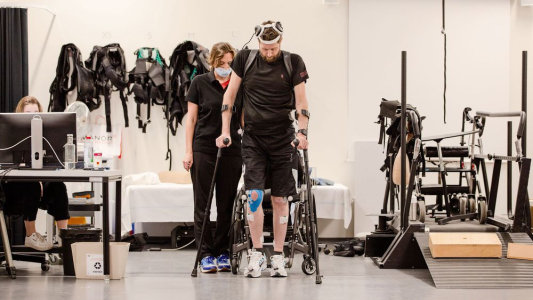Incredible breakthrough implant helps paralysed man walk for the first time in a decade!
Here at Seniors Discount Club, we are dedicated to keeping our members informed on the latest and most inspiring news. Today, we are excited to share with you all an incredible breakthrough in medical technology that has quite literally changed the life of a man living with paralysis.
A team of brilliant researchers, led by Dr Grégoire Courtine from the Swiss Federal Institute of Technology in Lausanne, has developed a groundbreaking 'brain-spine interface' implant. This innovative medical device has allowed a 40-year-old man, Gert-Jan Oskam from the Netherlands, to walk naturally again, over a decade after he was paralysed in a motorbike accident in China.
The implant system consists of two components—one part is placed in the brain, where it tracks intentions for movement, while the other component is implanted in the spinal cord. The movement intentions are then wirelessly transferred to a processing unit that the person wears externally, similar to a backpack.
Gert-Jan Oskam, who suffered from impaired leg, arm, and trunk movements due to his accident, said at a recent briefing, 'My wish was to walk again, and I believed it was possible. I tried many things before, and now I have to learn how to walk normal again, like natural, because this is how the system works.'
With the help of this revolutionary implant, Oskam is now able to walk at least 100 metres, depending on the day, and stand without using his hands for a few minutes. He even mentioned how useful it has been in his daily life for activities such as painting, where he needed to stand on his own.
One of the most amazing aspects of this story is the speed at which Gert-Jan Oskam was able to benefit from the implant. After the surgeries to place the devices, Oskam began taking steps within just one day of training! Furthermore, the neurological communication channels have remained stable and reliable for over a year, even during the time Oskam spent at home.
As the first participant in this trial, Gert-Jan Oskam's success has researchers feeling extremely hopeful about future possibilities. They believe that this technology can open up new opportunities for people suffering from arm and hand paralysis or those who have had strokes. However, the research team also expressed a desire to continue refining the system, making it even more portable and user-friendly.
Throughout the years, treatments and therapies for paralysis have advanced immensely — from the invention of the wheelchair to stimulated muscle movement. The aim is always to improve the quality of life for those affected by paralysis.
One of the oldest treatment techniques is physiotherapy, typically consisting of daily exercises that strive to counteract the effects of paralysis and increase mobility and strength. More recently, innovations such as the injection of stem cells into the spinal cord, electrical stimulation of muscles and even robot exoskeletons.
Though the traditional approach of surgeries and intense physiotherapy can be very effective, these more recently developed treatments can provide greater access to patients of all ages and levels of paralysis. As technology continues to evolve, so do the treatments used to alleviate the physical and personal struggles of those living with paralysis.
 The incredible research findings have been published in the esteemed Journal Nature, heralding a dawning of a new era in the treatment.
The incredible research findings have been published in the esteemed Journal Nature, heralding a dawning of a new era in the treatment.
To our dear members, we hope this inspirational story of perseverance and human ingenuity brightens your day. As we wrap up, we present you with a thought-provoking question: If given a chance to contribute to a monumental medical breakthrough, would you aspire to be part of a team working towards curing cancer, tackling a rare disease, or perhaps another area of medicine close to your heart?
Stay tuned for more incredible breakthroughs and news that may shape our futures.
A team of brilliant researchers, led by Dr Grégoire Courtine from the Swiss Federal Institute of Technology in Lausanne, has developed a groundbreaking 'brain-spine interface' implant. This innovative medical device has allowed a 40-year-old man, Gert-Jan Oskam from the Netherlands, to walk naturally again, over a decade after he was paralysed in a motorbike accident in China.
The implant system consists of two components—one part is placed in the brain, where it tracks intentions for movement, while the other component is implanted in the spinal cord. The movement intentions are then wirelessly transferred to a processing unit that the person wears externally, similar to a backpack.
Gert-Jan Oskam, who suffered from impaired leg, arm, and trunk movements due to his accident, said at a recent briefing, 'My wish was to walk again, and I believed it was possible. I tried many things before, and now I have to learn how to walk normal again, like natural, because this is how the system works.'
With the help of this revolutionary implant, Oskam is now able to walk at least 100 metres, depending on the day, and stand without using his hands for a few minutes. He even mentioned how useful it has been in his daily life for activities such as painting, where he needed to stand on his own.
One of the most amazing aspects of this story is the speed at which Gert-Jan Oskam was able to benefit from the implant. After the surgeries to place the devices, Oskam began taking steps within just one day of training! Furthermore, the neurological communication channels have remained stable and reliable for over a year, even during the time Oskam spent at home.
As the first participant in this trial, Gert-Jan Oskam's success has researchers feeling extremely hopeful about future possibilities. They believe that this technology can open up new opportunities for people suffering from arm and hand paralysis or those who have had strokes. However, the research team also expressed a desire to continue refining the system, making it even more portable and user-friendly.
Paralysis Therapies and Treatments Through the Years
Throughout the years, treatments and therapies for paralysis have advanced immensely — from the invention of the wheelchair to stimulated muscle movement. The aim is always to improve the quality of life for those affected by paralysis.
One of the oldest treatment techniques is physiotherapy, typically consisting of daily exercises that strive to counteract the effects of paralysis and increase mobility and strength. More recently, innovations such as the injection of stem cells into the spinal cord, electrical stimulation of muscles and even robot exoskeletons.
Though the traditional approach of surgeries and intense physiotherapy can be very effective, these more recently developed treatments can provide greater access to patients of all ages and levels of paralysis. As technology continues to evolve, so do the treatments used to alleviate the physical and personal struggles of those living with paralysis.
Key Takeaways
- A man with paralysis walked for the first time in a decade, thanks to a groundbreaking implant called a 'brain-spine interface’.
- The implant, developed by Dr Grégoire Courtine and colleagues from the Swiss Federal Institute of Technology, creates a direct neurological link between the brain and spinal cord.
- The study participant, Gert-Jan Oskam, can now walk at least 100 metres and stand without using his hands for a few minutes.
- This research validates the possibility of re-creating a neurological link between the brain and spinal cord, which could potentially help people with arm and hand paralysis or those who have had a stroke.
To our dear members, we hope this inspirational story of perseverance and human ingenuity brightens your day. As we wrap up, we present you with a thought-provoking question: If given a chance to contribute to a monumental medical breakthrough, would you aspire to be part of a team working towards curing cancer, tackling a rare disease, or perhaps another area of medicine close to your heart?
Stay tuned for more incredible breakthroughs and news that may shape our futures.








